Issues in Human Resource Management: Contemporary Challenges, Job Description and Person Specification, Performance Management in Intercontinental Hotel Group
VerifiedAdded on 2023/06/11
|16
|4990
|410
AI Summary
This report discusses the contemporary challenges in Human Resource Management in the hospitality industry, including workforce diversity, embracing new technology, and going global. It also provides examples of job description and person specification for managerial positions in Intercontinental Hotel Group and outlines the importance of performance management in minimizing staff turnover, enhancing promotions, and identifying training needs.
Contribute Materials
Your contribution can guide someone’s learning journey. Share your
documents today.
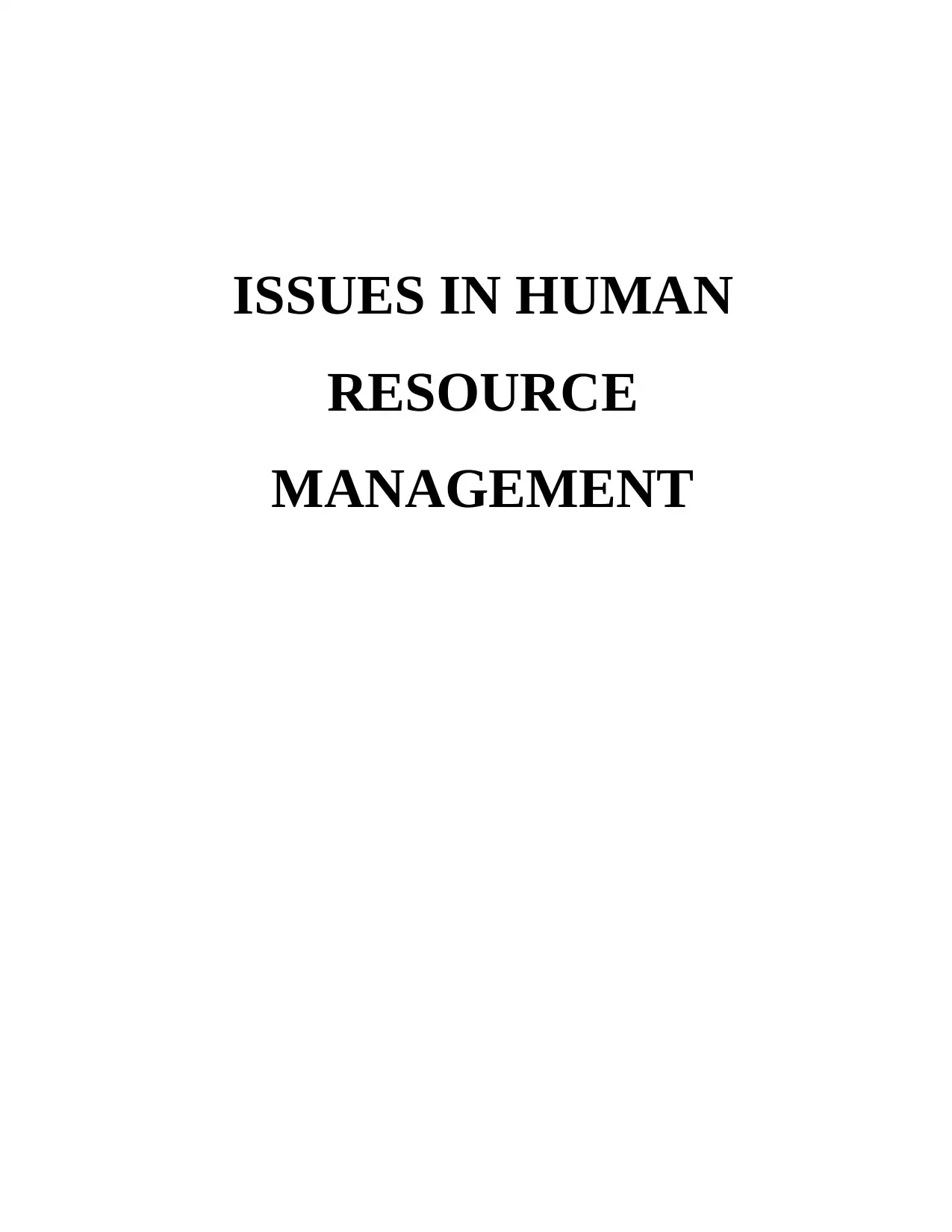
ISSUES IN HUMAN
RESOURCE
MANAGEMENT
RESOURCE
MANAGEMENT
Secure Best Marks with AI Grader
Need help grading? Try our AI Grader for instant feedback on your assignments.
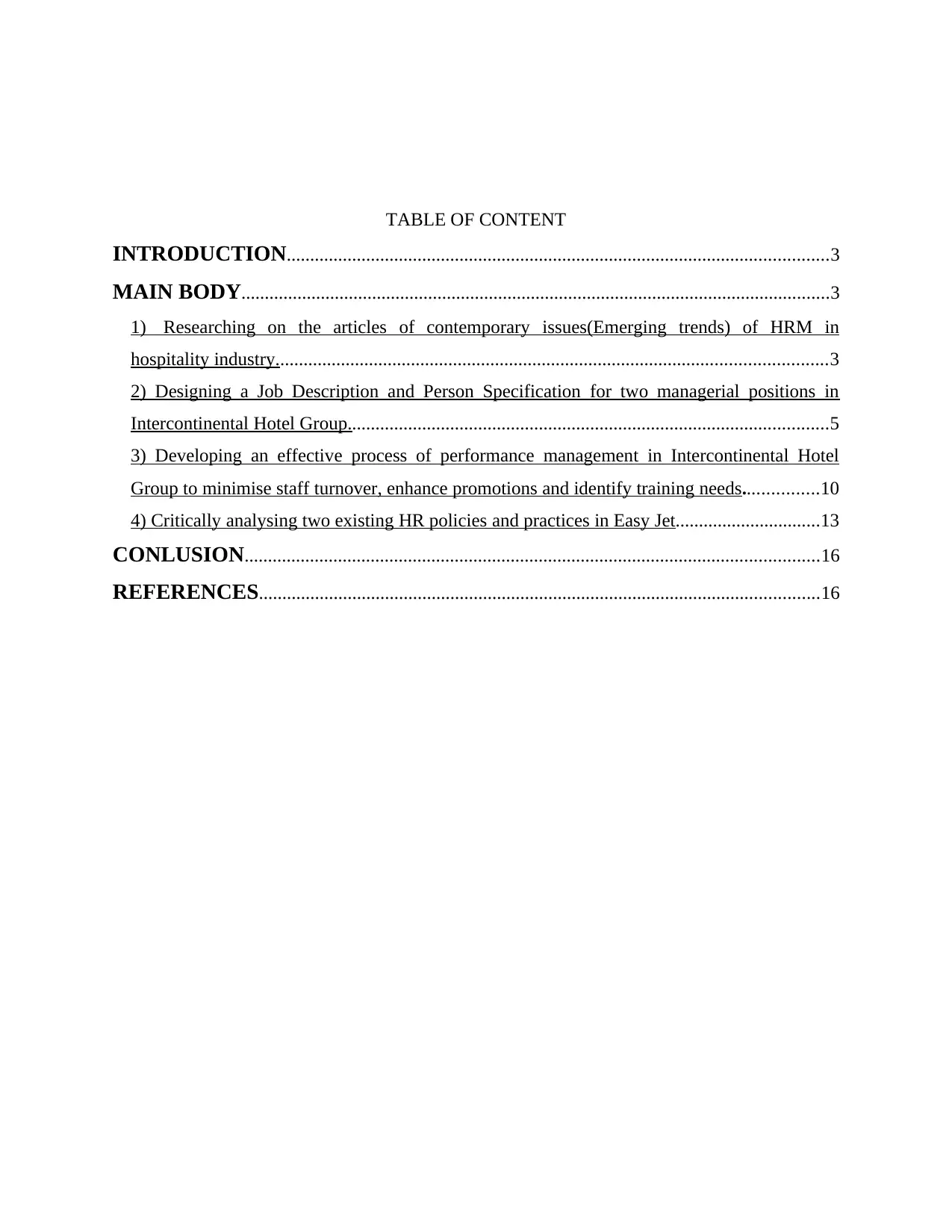
TABLE OF CONTENT
INTRODUCTION....................................................................................................................3
MAIN BODY..............................................................................................................................3
1) Researching on the articles of contemporary issues(Emerging trends) of HRM in
hospitality industry......................................................................................................................3
2) Designing a Job Description and Person Specification for two managerial positions in
Intercontinental Hotel Group.......................................................................................................5
3) Developing an effective process of performance management in Intercontinental Hotel
Group to minimise staff turnover, enhance promotions and identify training needs................10
4) Critically analysing two existing HR policies and practices in Easy Jet...............................13
CONLUSION...........................................................................................................................16
REFERENCES........................................................................................................................16
INTRODUCTION....................................................................................................................3
MAIN BODY..............................................................................................................................3
1) Researching on the articles of contemporary issues(Emerging trends) of HRM in
hospitality industry......................................................................................................................3
2) Designing a Job Description and Person Specification for two managerial positions in
Intercontinental Hotel Group.......................................................................................................5
3) Developing an effective process of performance management in Intercontinental Hotel
Group to minimise staff turnover, enhance promotions and identify training needs................10
4) Critically analysing two existing HR policies and practices in Easy Jet...............................13
CONLUSION...........................................................................................................................16
REFERENCES........................................................................................................................16
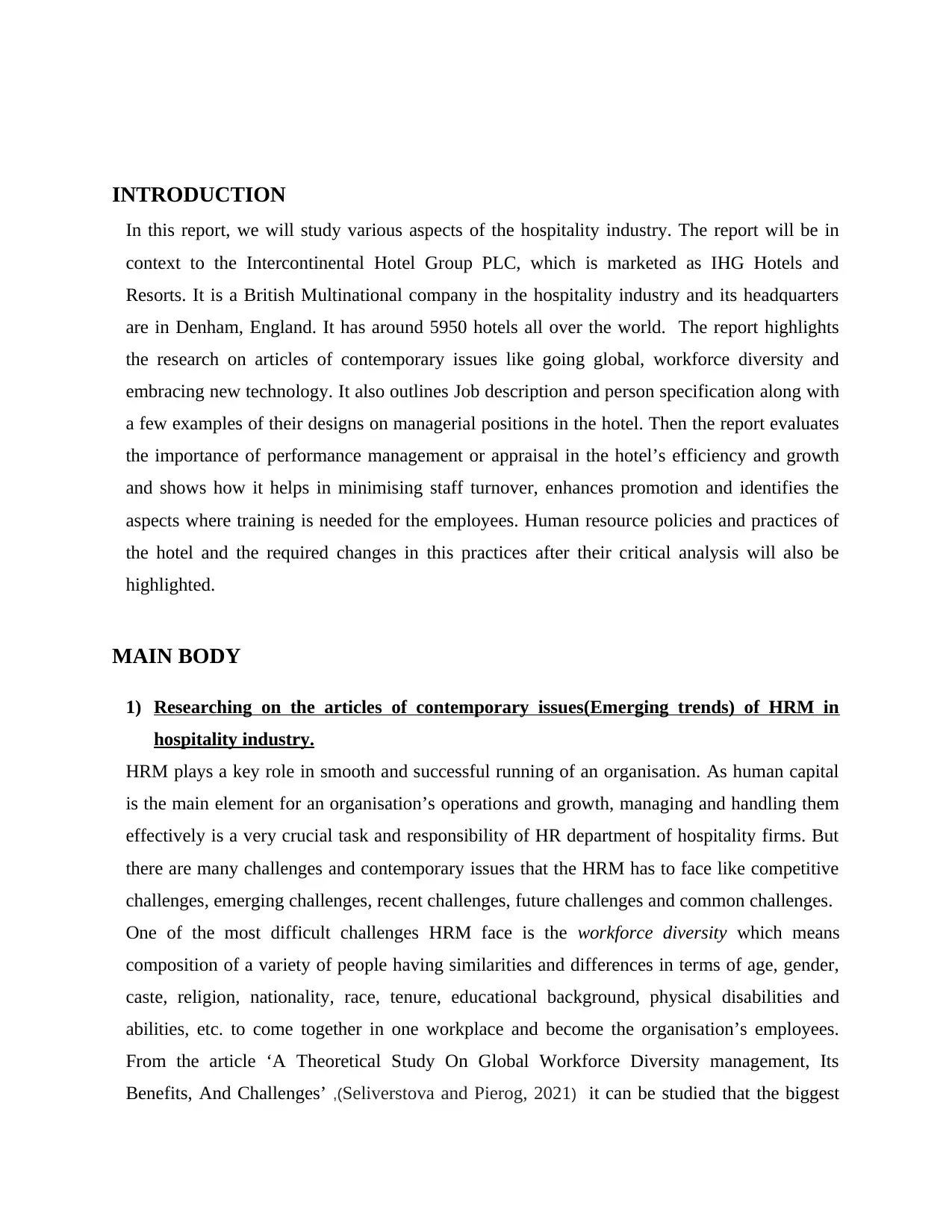
INTRODUCTION
In this report, we will study various aspects of the hospitality industry. The report will be in
context to the Intercontinental Hotel Group PLC, which is marketed as IHG Hotels and
Resorts. It is a British Multinational company in the hospitality industry and its headquarters
are in Denham, England. It has around 5950 hotels all over the world. The report highlights
the research on articles of contemporary issues like going global, workforce diversity and
embracing new technology. It also outlines Job description and person specification along with
a few examples of their designs on managerial positions in the hotel. Then the report evaluates
the importance of performance management or appraisal in the hotel’s efficiency and growth
and shows how it helps in minimising staff turnover, enhances promotion and identifies the
aspects where training is needed for the employees. Human resource policies and practices of
the hotel and the required changes in this practices after their critical analysis will also be
highlighted.
MAIN BODY
1) Researching on the articles of contemporary issues(Emerging trends) of HRM in
hospitality industry.
HRM plays a key role in smooth and successful running of an organisation. As human capital
is the main element for an organisation’s operations and growth, managing and handling them
effectively is a very crucial task and responsibility of HR department of hospitality firms. But
there are many challenges and contemporary issues that the HRM has to face like competitive
challenges, emerging challenges, recent challenges, future challenges and common challenges.
One of the most difficult challenges HRM face is the workforce diversity which means
composition of a variety of people having similarities and differences in terms of age, gender,
caste, religion, nationality, race, tenure, educational background, physical disabilities and
abilities, etc. to come together in one workplace and become the organisation’s employees.
From the article ‘A Theoretical Study On Global Workforce Diversity management, Its
Benefits, And Challenges’ ,(Seliverstova and Pierog, 2021) it can be studied that the biggest
In this report, we will study various aspects of the hospitality industry. The report will be in
context to the Intercontinental Hotel Group PLC, which is marketed as IHG Hotels and
Resorts. It is a British Multinational company in the hospitality industry and its headquarters
are in Denham, England. It has around 5950 hotels all over the world. The report highlights
the research on articles of contemporary issues like going global, workforce diversity and
embracing new technology. It also outlines Job description and person specification along with
a few examples of their designs on managerial positions in the hotel. Then the report evaluates
the importance of performance management or appraisal in the hotel’s efficiency and growth
and shows how it helps in minimising staff turnover, enhances promotion and identifies the
aspects where training is needed for the employees. Human resource policies and practices of
the hotel and the required changes in this practices after their critical analysis will also be
highlighted.
MAIN BODY
1) Researching on the articles of contemporary issues(Emerging trends) of HRM in
hospitality industry.
HRM plays a key role in smooth and successful running of an organisation. As human capital
is the main element for an organisation’s operations and growth, managing and handling them
effectively is a very crucial task and responsibility of HR department of hospitality firms. But
there are many challenges and contemporary issues that the HRM has to face like competitive
challenges, emerging challenges, recent challenges, future challenges and common challenges.
One of the most difficult challenges HRM face is the workforce diversity which means
composition of a variety of people having similarities and differences in terms of age, gender,
caste, religion, nationality, race, tenure, educational background, physical disabilities and
abilities, etc. to come together in one workplace and become the organisation’s employees.
From the article ‘A Theoretical Study On Global Workforce Diversity management, Its
Benefits, And Challenges’ ,(Seliverstova and Pierog, 2021) it can be studied that the biggest
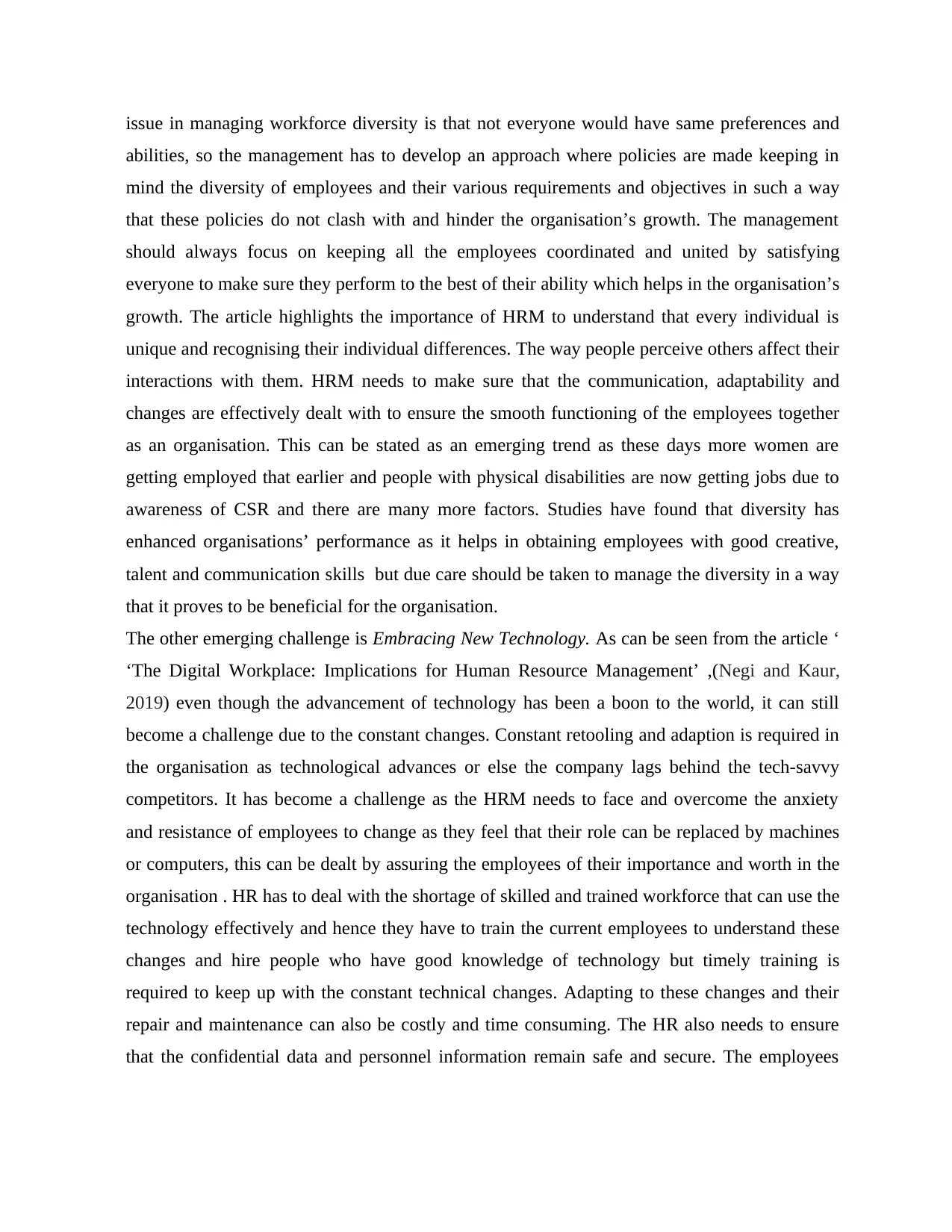
issue in managing workforce diversity is that not everyone would have same preferences and
abilities, so the management has to develop an approach where policies are made keeping in
mind the diversity of employees and their various requirements and objectives in such a way
that these policies do not clash with and hinder the organisation’s growth. The management
should always focus on keeping all the employees coordinated and united by satisfying
everyone to make sure they perform to the best of their ability which helps in the organisation’s
growth. The article highlights the importance of HRM to understand that every individual is
unique and recognising their individual differences. The way people perceive others affect their
interactions with them. HRM needs to make sure that the communication, adaptability and
changes are effectively dealt with to ensure the smooth functioning of the employees together
as an organisation. This can be stated as an emerging trend as these days more women are
getting employed that earlier and people with physical disabilities are now getting jobs due to
awareness of CSR and there are many more factors. Studies have found that diversity has
enhanced organisations’ performance as it helps in obtaining employees with good creative,
talent and communication skills but due care should be taken to manage the diversity in a way
that it proves to be beneficial for the organisation.
The other emerging challenge is Embracing New Technology. As can be seen from the article ‘
‘The Digital Workplace: Implications for Human Resource Management’ ,(Negi and Kaur,
2019) even though the advancement of technology has been a boon to the world, it can still
become a challenge due to the constant changes. Constant retooling and adaption is required in
the organisation as technological advances or else the company lags behind the tech-savvy
competitors. It has become a challenge as the HRM needs to face and overcome the anxiety
and resistance of employees to change as they feel that their role can be replaced by machines
or computers, this can be dealt by assuring the employees of their importance and worth in the
organisation . HR has to deal with the shortage of skilled and trained workforce that can use the
technology effectively and hence they have to train the current employees to understand these
changes and hire people who have good knowledge of technology but timely training is
required to keep up with the constant technical changes. Adapting to these changes and their
repair and maintenance can also be costly and time consuming. The HR also needs to ensure
that the confidential data and personnel information remain safe and secure. The employees
abilities, so the management has to develop an approach where policies are made keeping in
mind the diversity of employees and their various requirements and objectives in such a way
that these policies do not clash with and hinder the organisation’s growth. The management
should always focus on keeping all the employees coordinated and united by satisfying
everyone to make sure they perform to the best of their ability which helps in the organisation’s
growth. The article highlights the importance of HRM to understand that every individual is
unique and recognising their individual differences. The way people perceive others affect their
interactions with them. HRM needs to make sure that the communication, adaptability and
changes are effectively dealt with to ensure the smooth functioning of the employees together
as an organisation. This can be stated as an emerging trend as these days more women are
getting employed that earlier and people with physical disabilities are now getting jobs due to
awareness of CSR and there are many more factors. Studies have found that diversity has
enhanced organisations’ performance as it helps in obtaining employees with good creative,
talent and communication skills but due care should be taken to manage the diversity in a way
that it proves to be beneficial for the organisation.
The other emerging challenge is Embracing New Technology. As can be seen from the article ‘
‘The Digital Workplace: Implications for Human Resource Management’ ,(Negi and Kaur,
2019) even though the advancement of technology has been a boon to the world, it can still
become a challenge due to the constant changes. Constant retooling and adaption is required in
the organisation as technological advances or else the company lags behind the tech-savvy
competitors. It has become a challenge as the HRM needs to face and overcome the anxiety
and resistance of employees to change as they feel that their role can be replaced by machines
or computers, this can be dealt by assuring the employees of their importance and worth in the
organisation . HR has to deal with the shortage of skilled and trained workforce that can use the
technology effectively and hence they have to train the current employees to understand these
changes and hire people who have good knowledge of technology but timely training is
required to keep up with the constant technical changes. Adapting to these changes and their
repair and maintenance can also be costly and time consuming. The HR also needs to ensure
that the confidential data and personnel information remain safe and secure. The employees
Secure Best Marks with AI Grader
Need help grading? Try our AI Grader for instant feedback on your assignments.
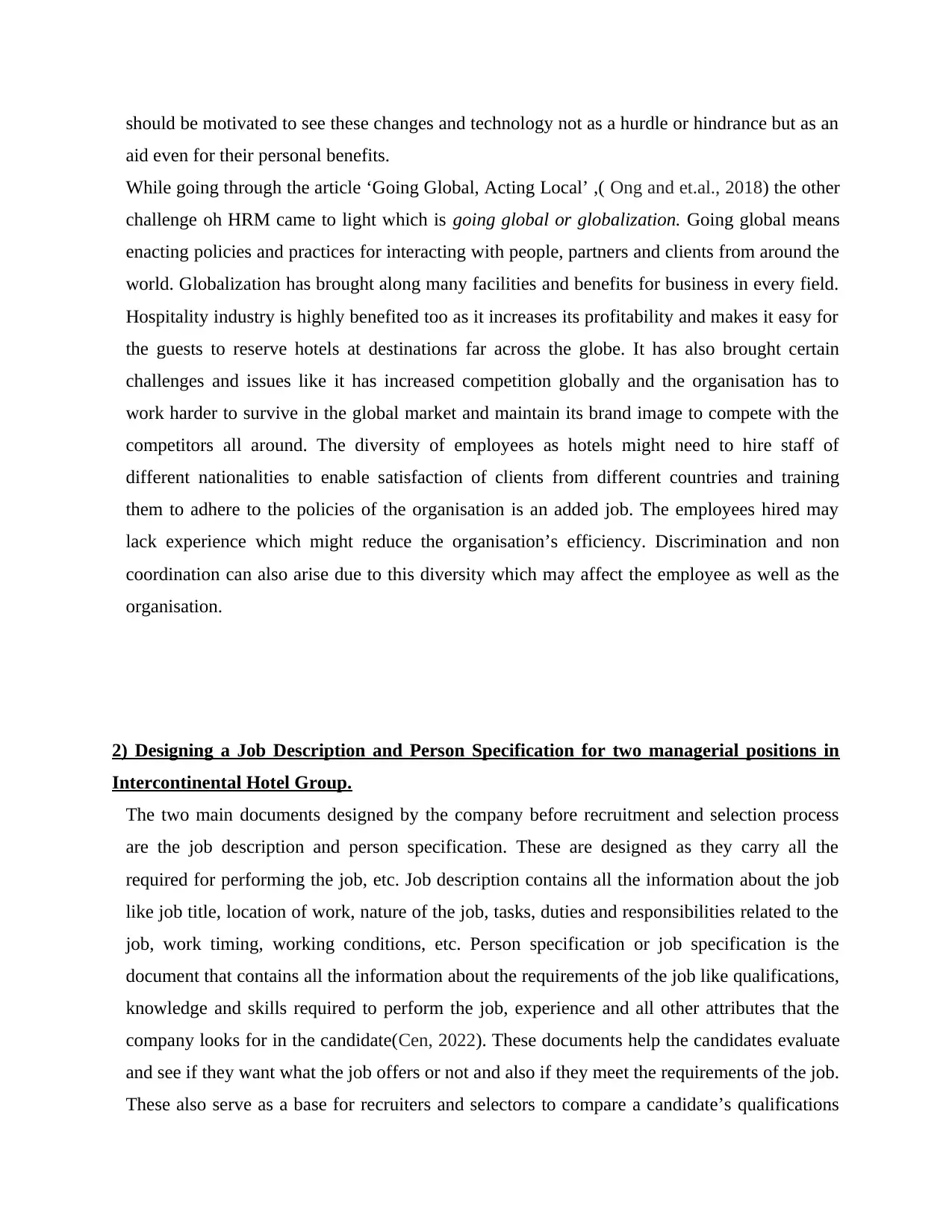
should be motivated to see these changes and technology not as a hurdle or hindrance but as an
aid even for their personal benefits.
While going through the article ‘Going Global, Acting Local’ ,( Ong and et.al., 2018) the other
challenge oh HRM came to light which is going global or globalization. Going global means
enacting policies and practices for interacting with people, partners and clients from around the
world. Globalization has brought along many facilities and benefits for business in every field.
Hospitality industry is highly benefited too as it increases its profitability and makes it easy for
the guests to reserve hotels at destinations far across the globe. It has also brought certain
challenges and issues like it has increased competition globally and the organisation has to
work harder to survive in the global market and maintain its brand image to compete with the
competitors all around. The diversity of employees as hotels might need to hire staff of
different nationalities to enable satisfaction of clients from different countries and training
them to adhere to the policies of the organisation is an added job. The employees hired may
lack experience which might reduce the organisation’s efficiency. Discrimination and non
coordination can also arise due to this diversity which may affect the employee as well as the
organisation.
2) Designing a Job Description and Person Specification for two managerial positions in
Intercontinental Hotel Group.
The two main documents designed by the company before recruitment and selection process
are the job description and person specification. These are designed as they carry all the
required for performing the job, etc. Job description contains all the information about the job
like job title, location of work, nature of the job, tasks, duties and responsibilities related to the
job, work timing, working conditions, etc. Person specification or job specification is the
document that contains all the information about the requirements of the job like qualifications,
knowledge and skills required to perform the job, experience and all other attributes that the
company looks for in the candidate(Cen, 2022). These documents help the candidates evaluate
and see if they want what the job offers or not and also if they meet the requirements of the job.
These also serve as a base for recruiters and selectors to compare a candidate’s qualifications
aid even for their personal benefits.
While going through the article ‘Going Global, Acting Local’ ,( Ong and et.al., 2018) the other
challenge oh HRM came to light which is going global or globalization. Going global means
enacting policies and practices for interacting with people, partners and clients from around the
world. Globalization has brought along many facilities and benefits for business in every field.
Hospitality industry is highly benefited too as it increases its profitability and makes it easy for
the guests to reserve hotels at destinations far across the globe. It has also brought certain
challenges and issues like it has increased competition globally and the organisation has to
work harder to survive in the global market and maintain its brand image to compete with the
competitors all around. The diversity of employees as hotels might need to hire staff of
different nationalities to enable satisfaction of clients from different countries and training
them to adhere to the policies of the organisation is an added job. The employees hired may
lack experience which might reduce the organisation’s efficiency. Discrimination and non
coordination can also arise due to this diversity which may affect the employee as well as the
organisation.
2) Designing a Job Description and Person Specification for two managerial positions in
Intercontinental Hotel Group.
The two main documents designed by the company before recruitment and selection process
are the job description and person specification. These are designed as they carry all the
required for performing the job, etc. Job description contains all the information about the job
like job title, location of work, nature of the job, tasks, duties and responsibilities related to the
job, work timing, working conditions, etc. Person specification or job specification is the
document that contains all the information about the requirements of the job like qualifications,
knowledge and skills required to perform the job, experience and all other attributes that the
company looks for in the candidate(Cen, 2022). These documents help the candidates evaluate
and see if they want what the job offers or not and also if they meet the requirements of the job.
These also serve as a base for recruiters and selectors to compare a candidate’s qualifications
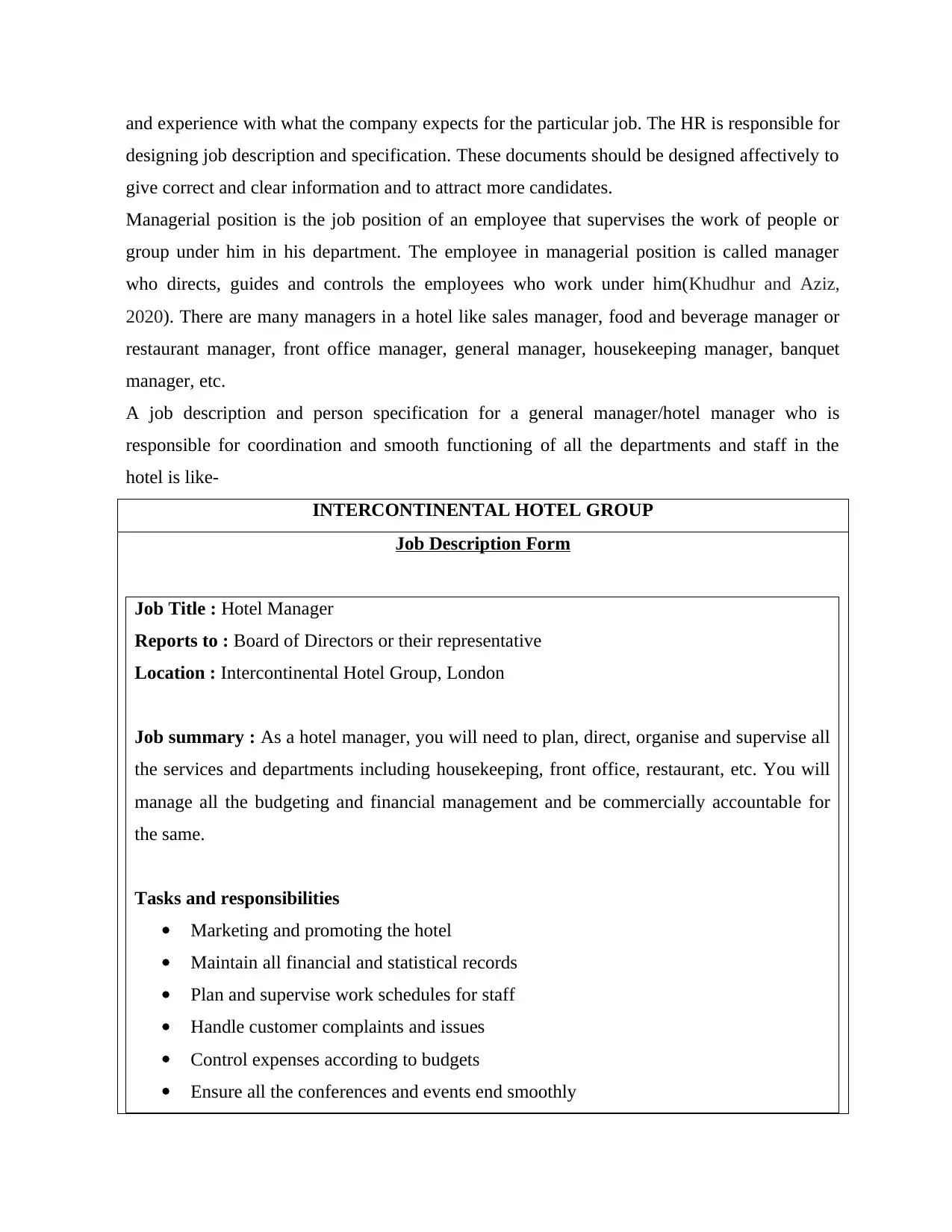
and experience with what the company expects for the particular job. The HR is responsible for
designing job description and specification. These documents should be designed affectively to
give correct and clear information and to attract more candidates.
Managerial position is the job position of an employee that supervises the work of people or
group under him in his department. The employee in managerial position is called manager
who directs, guides and controls the employees who work under him(Khudhur and Aziz,
2020). There are many managers in a hotel like sales manager, food and beverage manager or
restaurant manager, front office manager, general manager, housekeeping manager, banquet
manager, etc.
A job description and person specification for a general manager/hotel manager who is
responsible for coordination and smooth functioning of all the departments and staff in the
hotel is like-
INTERCONTINENTAL HOTEL GROUP
Job Description Form
Job Title : Hotel Manager
Reports to : Board of Directors or their representative
Location : Intercontinental Hotel Group, London
Job summary : As a hotel manager, you will need to plan, direct, organise and supervise all
the services and departments including housekeeping, front office, restaurant, etc. You will
manage all the budgeting and financial management and be commercially accountable for
the same.
Tasks and responsibilities
Marketing and promoting the hotel
Maintain all financial and statistical records
Plan and supervise work schedules for staff
Handle customer complaints and issues
Control expenses according to budgets
Ensure all the conferences and events end smoothly
designing job description and specification. These documents should be designed affectively to
give correct and clear information and to attract more candidates.
Managerial position is the job position of an employee that supervises the work of people or
group under him in his department. The employee in managerial position is called manager
who directs, guides and controls the employees who work under him(Khudhur and Aziz,
2020). There are many managers in a hotel like sales manager, food and beverage manager or
restaurant manager, front office manager, general manager, housekeeping manager, banquet
manager, etc.
A job description and person specification for a general manager/hotel manager who is
responsible for coordination and smooth functioning of all the departments and staff in the
hotel is like-
INTERCONTINENTAL HOTEL GROUP
Job Description Form
Job Title : Hotel Manager
Reports to : Board of Directors or their representative
Location : Intercontinental Hotel Group, London
Job summary : As a hotel manager, you will need to plan, direct, organise and supervise all
the services and departments including housekeeping, front office, restaurant, etc. You will
manage all the budgeting and financial management and be commercially accountable for
the same.
Tasks and responsibilities
Marketing and promoting the hotel
Maintain all financial and statistical records
Plan and supervise work schedules for staff
Handle customer complaints and issues
Control expenses according to budgets
Ensure all the conferences and events end smoothly
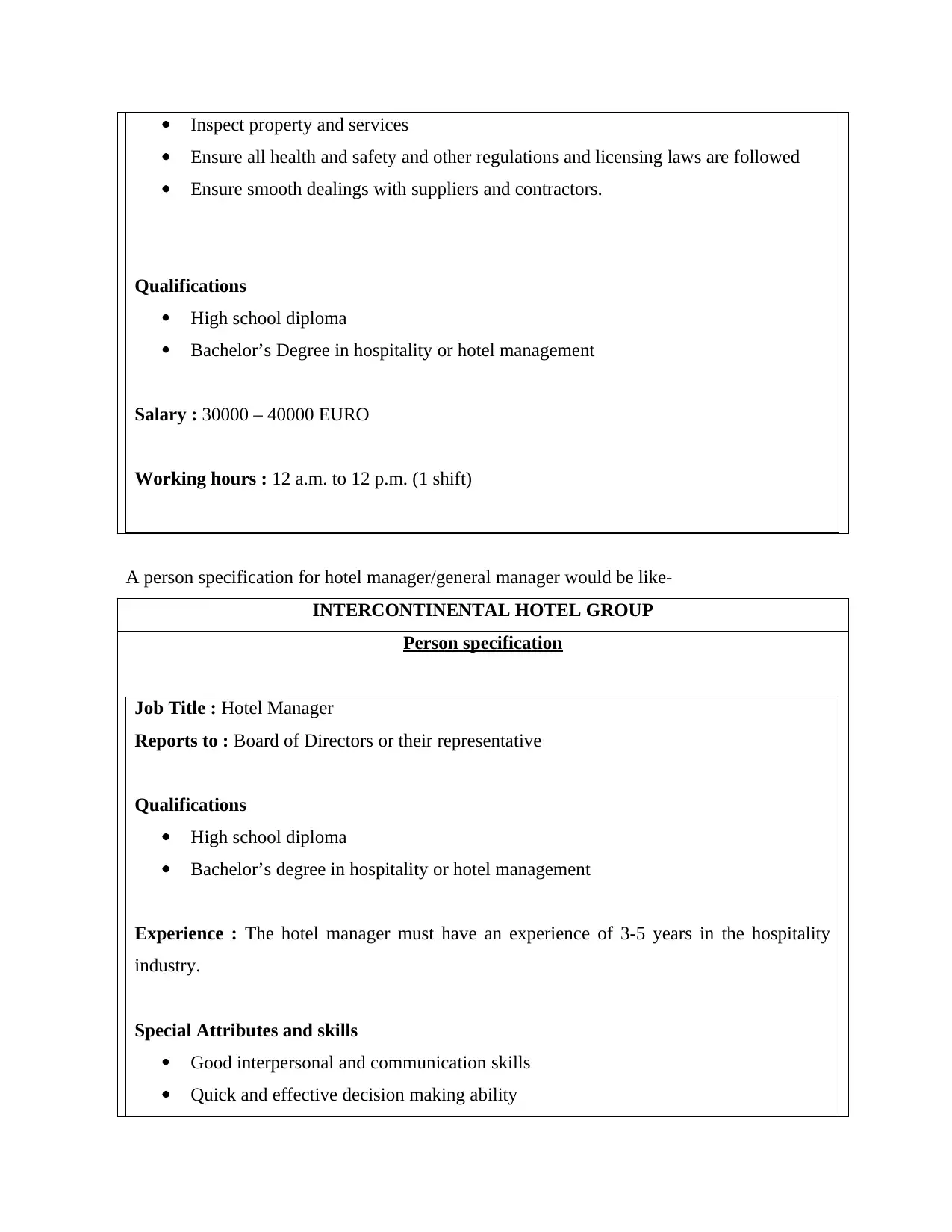
Inspect property and services
Ensure all health and safety and other regulations and licensing laws are followed
Ensure smooth dealings with suppliers and contractors.
Qualifications
High school diploma
Bachelor’s Degree in hospitality or hotel management
Salary : 30000 – 40000 EURO
Working hours : 12 a.m. to 12 p.m. (1 shift)
A person specification for hotel manager/general manager would be like-
INTERCONTINENTAL HOTEL GROUP
Person specification
Job Title : Hotel Manager
Reports to : Board of Directors or their representative
Qualifications
High school diploma
Bachelor’s degree in hospitality or hotel management
Experience : The hotel manager must have an experience of 3-5 years in the hospitality
industry.
Special Attributes and skills
Good interpersonal and communication skills
Quick and effective decision making ability
Ensure all health and safety and other regulations and licensing laws are followed
Ensure smooth dealings with suppliers and contractors.
Qualifications
High school diploma
Bachelor’s Degree in hospitality or hotel management
Salary : 30000 – 40000 EURO
Working hours : 12 a.m. to 12 p.m. (1 shift)
A person specification for hotel manager/general manager would be like-
INTERCONTINENTAL HOTEL GROUP
Person specification
Job Title : Hotel Manager
Reports to : Board of Directors or their representative
Qualifications
High school diploma
Bachelor’s degree in hospitality or hotel management
Experience : The hotel manager must have an experience of 3-5 years in the hospitality
industry.
Special Attributes and skills
Good interpersonal and communication skills
Quick and effective decision making ability
Paraphrase This Document
Need a fresh take? Get an instant paraphrase of this document with our AI Paraphraser
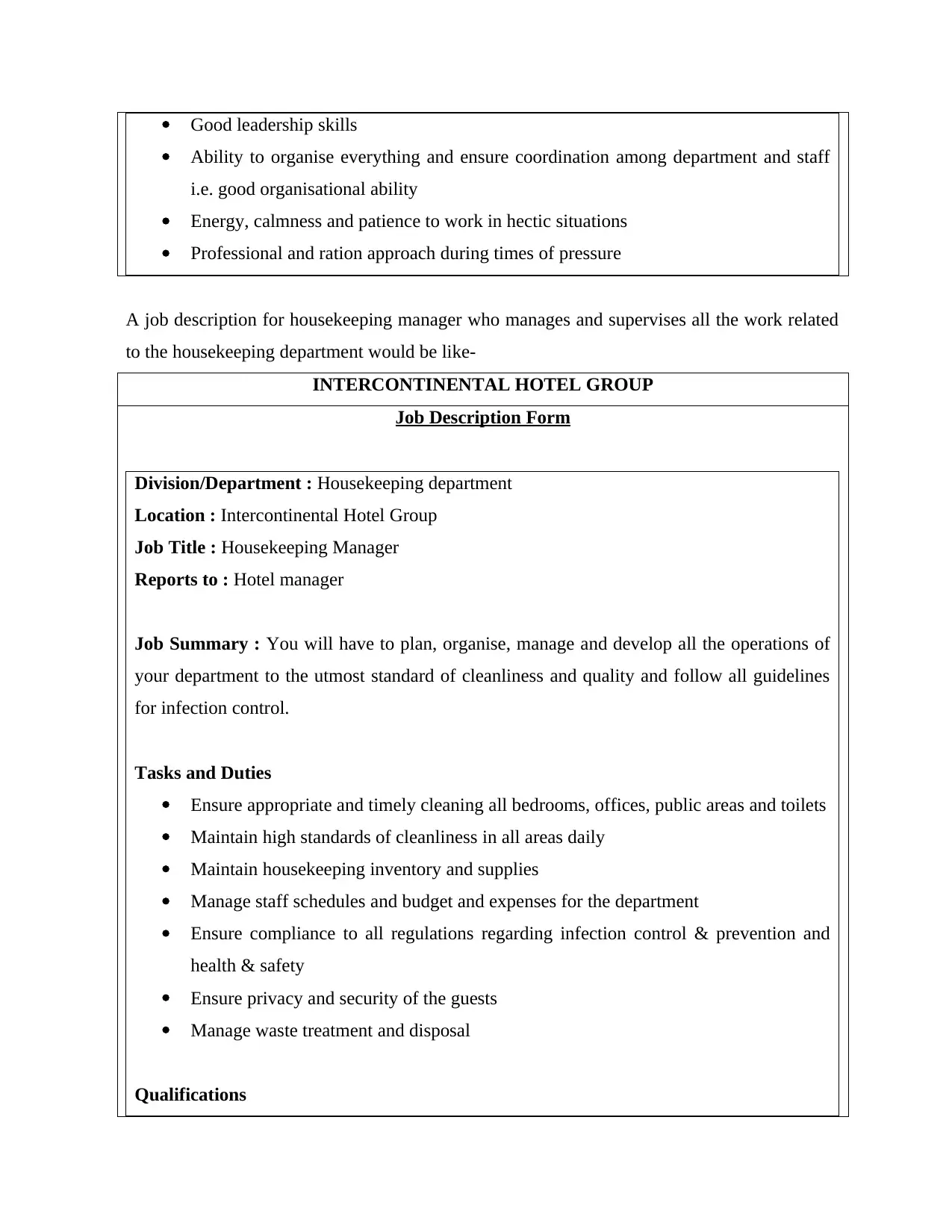
Good leadership skills
Ability to organise everything and ensure coordination among department and staff
i.e. good organisational ability
Energy, calmness and patience to work in hectic situations
Professional and ration approach during times of pressure
A job description for housekeeping manager who manages and supervises all the work related
to the housekeeping department would be like-
INTERCONTINENTAL HOTEL GROUP
Job Description Form
Division/Department : Housekeeping department
Location : Intercontinental Hotel Group
Job Title : Housekeeping Manager
Reports to : Hotel manager
Job Summary : You will have to plan, organise, manage and develop all the operations of
your department to the utmost standard of cleanliness and quality and follow all guidelines
for infection control.
Tasks and Duties
Ensure appropriate and timely cleaning all bedrooms, offices, public areas and toilets
Maintain high standards of cleanliness in all areas daily
Maintain housekeeping inventory and supplies
Manage staff schedules and budget and expenses for the department
Ensure compliance to all regulations regarding infection control & prevention and
health & safety
Ensure privacy and security of the guests
Manage waste treatment and disposal
Qualifications
Ability to organise everything and ensure coordination among department and staff
i.e. good organisational ability
Energy, calmness and patience to work in hectic situations
Professional and ration approach during times of pressure
A job description for housekeeping manager who manages and supervises all the work related
to the housekeeping department would be like-
INTERCONTINENTAL HOTEL GROUP
Job Description Form
Division/Department : Housekeeping department
Location : Intercontinental Hotel Group
Job Title : Housekeeping Manager
Reports to : Hotel manager
Job Summary : You will have to plan, organise, manage and develop all the operations of
your department to the utmost standard of cleanliness and quality and follow all guidelines
for infection control.
Tasks and Duties
Ensure appropriate and timely cleaning all bedrooms, offices, public areas and toilets
Maintain high standards of cleanliness in all areas daily
Maintain housekeeping inventory and supplies
Manage staff schedules and budget and expenses for the department
Ensure compliance to all regulations regarding infection control & prevention and
health & safety
Ensure privacy and security of the guests
Manage waste treatment and disposal
Qualifications
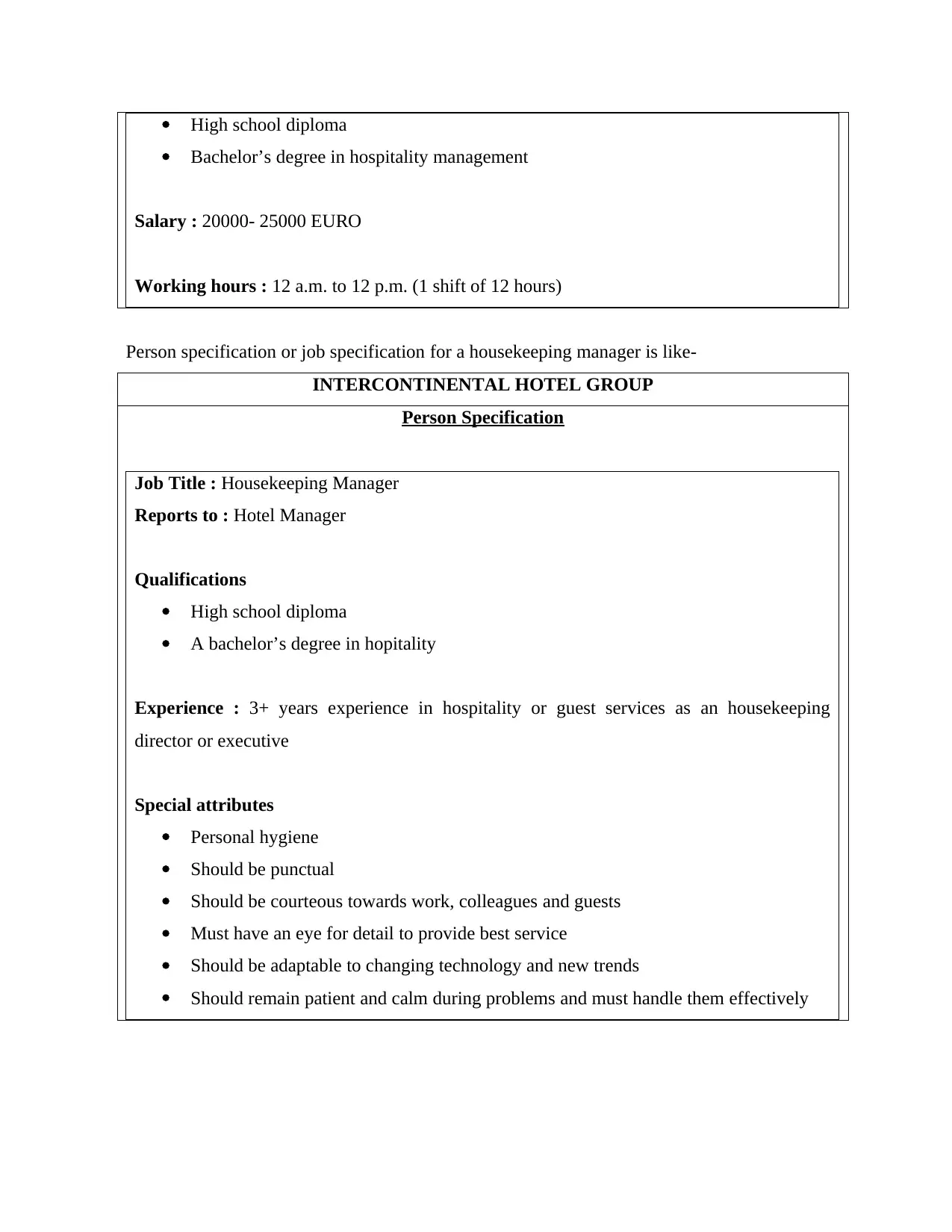
High school diploma
Bachelor’s degree in hospitality management
Salary : 20000- 25000 EURO
Working hours : 12 a.m. to 12 p.m. (1 shift of 12 hours)
Person specification or job specification for a housekeeping manager is like-
INTERCONTINENTAL HOTEL GROUP
Person Specification
Job Title : Housekeeping Manager
Reports to : Hotel Manager
Qualifications
High school diploma
A bachelor’s degree in hopitality
Experience : 3+ years experience in hospitality or guest services as an housekeeping
director or executive
Special attributes
Personal hygiene
Should be punctual
Should be courteous towards work, colleagues and guests
Must have an eye for detail to provide best service
Should be adaptable to changing technology and new trends
Should remain patient and calm during problems and must handle them effectively
Bachelor’s degree in hospitality management
Salary : 20000- 25000 EURO
Working hours : 12 a.m. to 12 p.m. (1 shift of 12 hours)
Person specification or job specification for a housekeeping manager is like-
INTERCONTINENTAL HOTEL GROUP
Person Specification
Job Title : Housekeeping Manager
Reports to : Hotel Manager
Qualifications
High school diploma
A bachelor’s degree in hopitality
Experience : 3+ years experience in hospitality or guest services as an housekeeping
director or executive
Special attributes
Personal hygiene
Should be punctual
Should be courteous towards work, colleagues and guests
Must have an eye for detail to provide best service
Should be adaptable to changing technology and new trends
Should remain patient and calm during problems and must handle them effectively
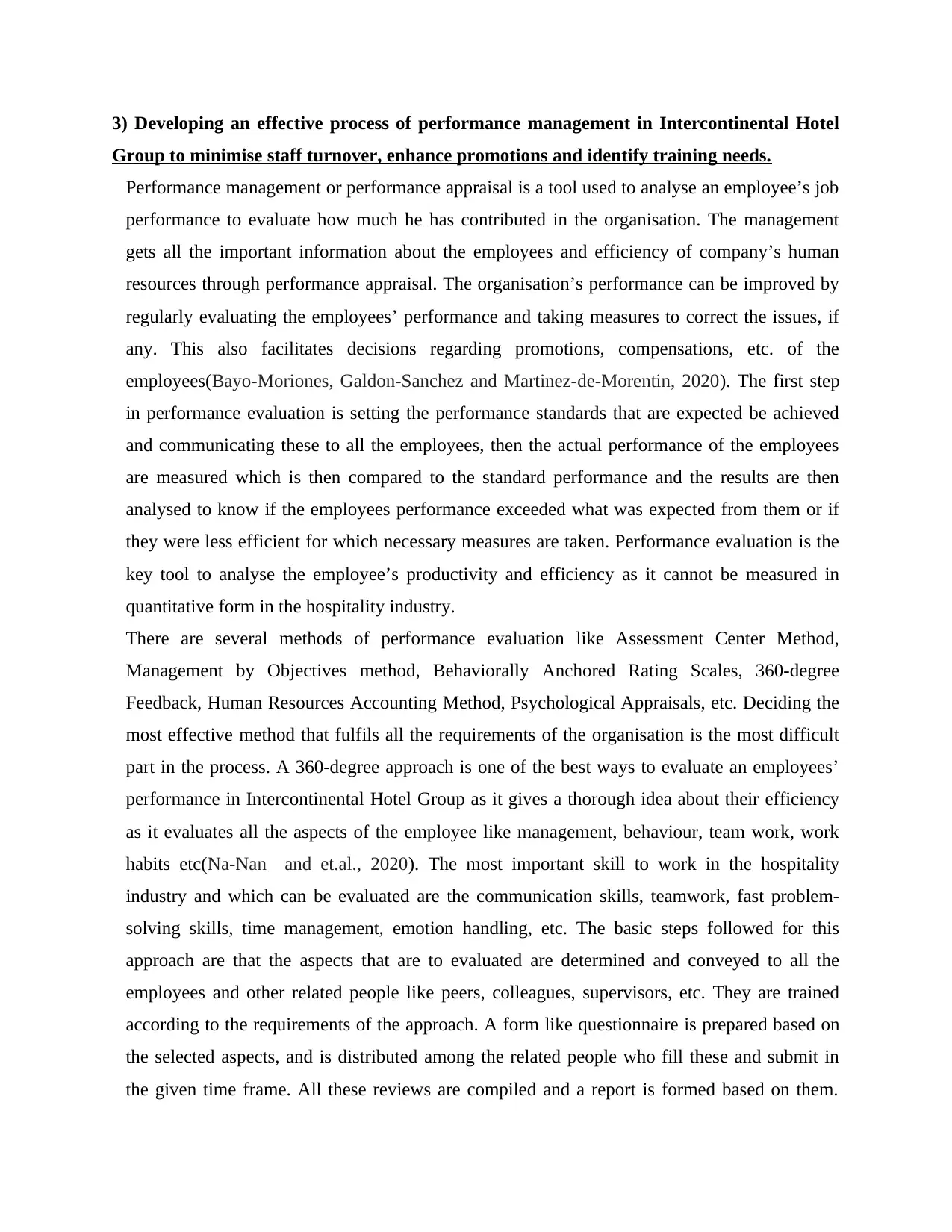
3) Developing an effective process of performance management in Intercontinental Hotel
Group to minimise staff turnover, enhance promotions and identify training needs.
Performance management or performance appraisal is a tool used to analyse an employee’s job
performance to evaluate how much he has contributed in the organisation. The management
gets all the important information about the employees and efficiency of company’s human
resources through performance appraisal. The organisation’s performance can be improved by
regularly evaluating the employees’ performance and taking measures to correct the issues, if
any. This also facilitates decisions regarding promotions, compensations, etc. of the
employees(Bayo-Moriones, Galdon-Sanchez and Martinez-de-Morentin, 2020). The first step
in performance evaluation is setting the performance standards that are expected be achieved
and communicating these to all the employees, then the actual performance of the employees
are measured which is then compared to the standard performance and the results are then
analysed to know if the employees performance exceeded what was expected from them or if
they were less efficient for which necessary measures are taken. Performance evaluation is the
key tool to analyse the employee’s productivity and efficiency as it cannot be measured in
quantitative form in the hospitality industry.
There are several methods of performance evaluation like Assessment Center Method,
Management by Objectives method, Behaviorally Anchored Rating Scales, 360-degree
Feedback, Human Resources Accounting Method, Psychological Appraisals, etc. Deciding the
most effective method that fulfils all the requirements of the organisation is the most difficult
part in the process. A 360-degree approach is one of the best ways to evaluate an employees’
performance in Intercontinental Hotel Group as it gives a thorough idea about their efficiency
as it evaluates all the aspects of the employee like management, behaviour, team work, work
habits etc(Na-Nan and et.al., 2020). The most important skill to work in the hospitality
industry and which can be evaluated are the communication skills, teamwork, fast problem-
solving skills, time management, emotion handling, etc. The basic steps followed for this
approach are that the aspects that are to evaluated are determined and conveyed to all the
employees and other related people like peers, colleagues, supervisors, etc. They are trained
according to the requirements of the approach. A form like questionnaire is prepared based on
the selected aspects, and is distributed among the related people who fill these and submit in
the given time frame. All these reviews are compiled and a report is formed based on them.
Group to minimise staff turnover, enhance promotions and identify training needs.
Performance management or performance appraisal is a tool used to analyse an employee’s job
performance to evaluate how much he has contributed in the organisation. The management
gets all the important information about the employees and efficiency of company’s human
resources through performance appraisal. The organisation’s performance can be improved by
regularly evaluating the employees’ performance and taking measures to correct the issues, if
any. This also facilitates decisions regarding promotions, compensations, etc. of the
employees(Bayo-Moriones, Galdon-Sanchez and Martinez-de-Morentin, 2020). The first step
in performance evaluation is setting the performance standards that are expected be achieved
and communicating these to all the employees, then the actual performance of the employees
are measured which is then compared to the standard performance and the results are then
analysed to know if the employees performance exceeded what was expected from them or if
they were less efficient for which necessary measures are taken. Performance evaluation is the
key tool to analyse the employee’s productivity and efficiency as it cannot be measured in
quantitative form in the hospitality industry.
There are several methods of performance evaluation like Assessment Center Method,
Management by Objectives method, Behaviorally Anchored Rating Scales, 360-degree
Feedback, Human Resources Accounting Method, Psychological Appraisals, etc. Deciding the
most effective method that fulfils all the requirements of the organisation is the most difficult
part in the process. A 360-degree approach is one of the best ways to evaluate an employees’
performance in Intercontinental Hotel Group as it gives a thorough idea about their efficiency
as it evaluates all the aspects of the employee like management, behaviour, team work, work
habits etc(Na-Nan and et.al., 2020). The most important skill to work in the hospitality
industry and which can be evaluated are the communication skills, teamwork, fast problem-
solving skills, time management, emotion handling, etc. The basic steps followed for this
approach are that the aspects that are to evaluated are determined and conveyed to all the
employees and other related people like peers, colleagues, supervisors, etc. They are trained
according to the requirements of the approach. A form like questionnaire is prepared based on
the selected aspects, and is distributed among the related people who fill these and submit in
the given time frame. All these reviews are compiled and a report is formed based on them.
Secure Best Marks with AI Grader
Need help grading? Try our AI Grader for instant feedback on your assignments.
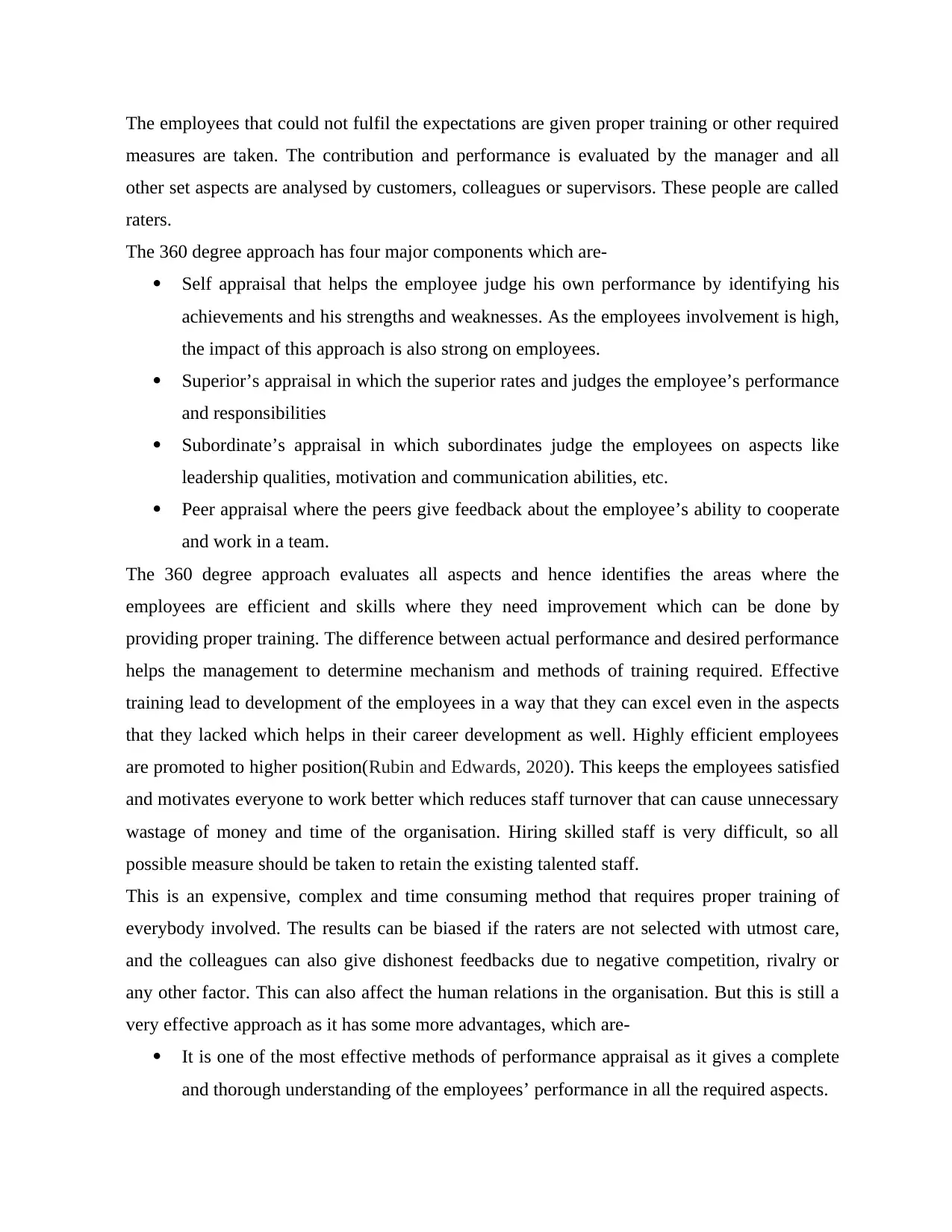
The employees that could not fulfil the expectations are given proper training or other required
measures are taken. The contribution and performance is evaluated by the manager and all
other set aspects are analysed by customers, colleagues or supervisors. These people are called
raters.
The 360 degree approach has four major components which are-
Self appraisal that helps the employee judge his own performance by identifying his
achievements and his strengths and weaknesses. As the employees involvement is high,
the impact of this approach is also strong on employees.
Superior’s appraisal in which the superior rates and judges the employee’s performance
and responsibilities
Subordinate’s appraisal in which subordinates judge the employees on aspects like
leadership qualities, motivation and communication abilities, etc.
Peer appraisal where the peers give feedback about the employee’s ability to cooperate
and work in a team.
The 360 degree approach evaluates all aspects and hence identifies the areas where the
employees are efficient and skills where they need improvement which can be done by
providing proper training. The difference between actual performance and desired performance
helps the management to determine mechanism and methods of training required. Effective
training lead to development of the employees in a way that they can excel even in the aspects
that they lacked which helps in their career development as well. Highly efficient employees
are promoted to higher position(Rubin and Edwards, 2020). This keeps the employees satisfied
and motivates everyone to work better which reduces staff turnover that can cause unnecessary
wastage of money and time of the organisation. Hiring skilled staff is very difficult, so all
possible measure should be taken to retain the existing talented staff.
This is an expensive, complex and time consuming method that requires proper training of
everybody involved. The results can be biased if the raters are not selected with utmost care,
and the colleagues can also give dishonest feedbacks due to negative competition, rivalry or
any other factor. This can also affect the human relations in the organisation. But this is still a
very effective approach as it has some more advantages, which are-
It is one of the most effective methods of performance appraisal as it gives a complete
and thorough understanding of the employees’ performance in all the required aspects.
measures are taken. The contribution and performance is evaluated by the manager and all
other set aspects are analysed by customers, colleagues or supervisors. These people are called
raters.
The 360 degree approach has four major components which are-
Self appraisal that helps the employee judge his own performance by identifying his
achievements and his strengths and weaknesses. As the employees involvement is high,
the impact of this approach is also strong on employees.
Superior’s appraisal in which the superior rates and judges the employee’s performance
and responsibilities
Subordinate’s appraisal in which subordinates judge the employees on aspects like
leadership qualities, motivation and communication abilities, etc.
Peer appraisal where the peers give feedback about the employee’s ability to cooperate
and work in a team.
The 360 degree approach evaluates all aspects and hence identifies the areas where the
employees are efficient and skills where they need improvement which can be done by
providing proper training. The difference between actual performance and desired performance
helps the management to determine mechanism and methods of training required. Effective
training lead to development of the employees in a way that they can excel even in the aspects
that they lacked which helps in their career development as well. Highly efficient employees
are promoted to higher position(Rubin and Edwards, 2020). This keeps the employees satisfied
and motivates everyone to work better which reduces staff turnover that can cause unnecessary
wastage of money and time of the organisation. Hiring skilled staff is very difficult, so all
possible measure should be taken to retain the existing talented staff.
This is an expensive, complex and time consuming method that requires proper training of
everybody involved. The results can be biased if the raters are not selected with utmost care,
and the colleagues can also give dishonest feedbacks due to negative competition, rivalry or
any other factor. This can also affect the human relations in the organisation. But this is still a
very effective approach as it has some more advantages, which are-
It is one of the most effective methods of performance appraisal as it gives a complete
and thorough understanding of the employees’ performance in all the required aspects.
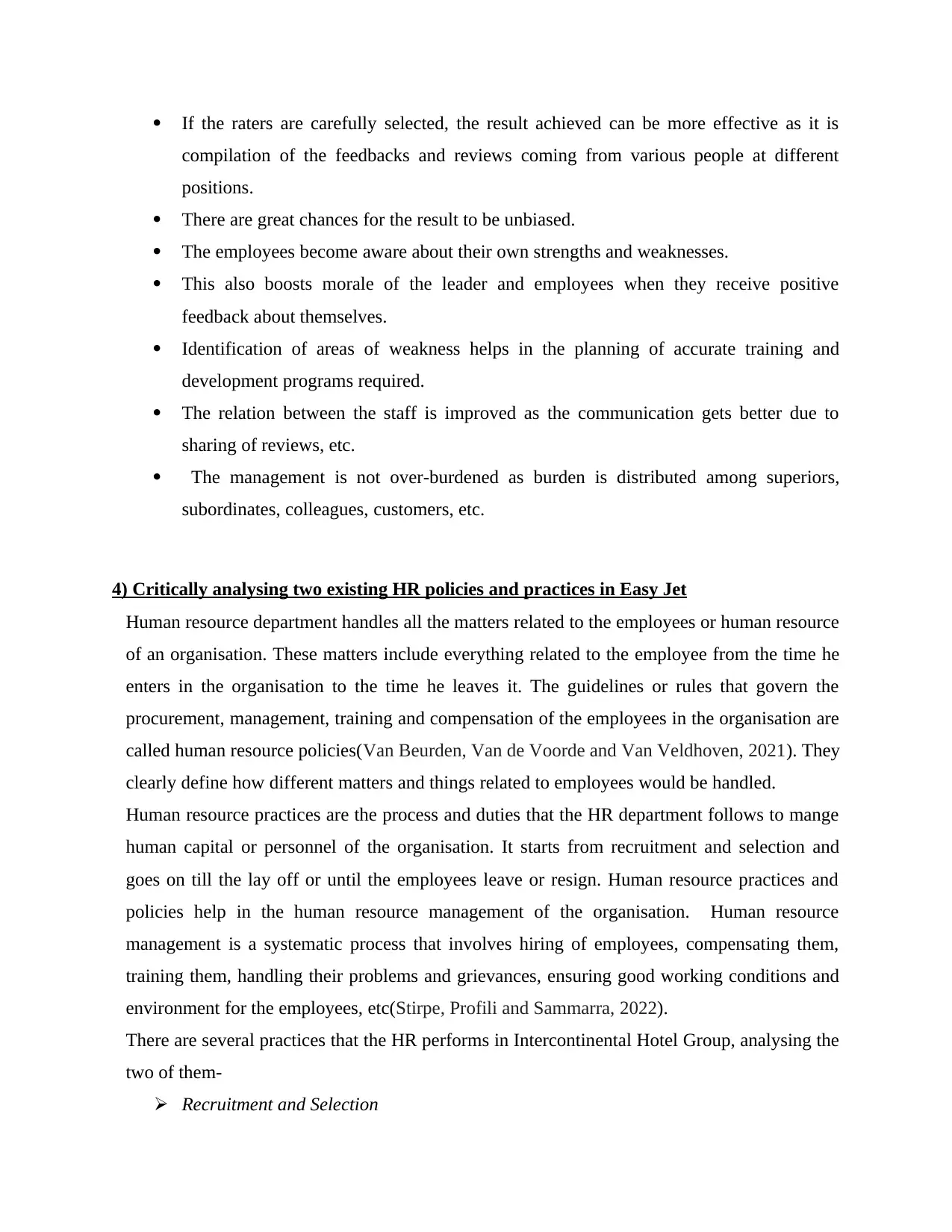
If the raters are carefully selected, the result achieved can be more effective as it is
compilation of the feedbacks and reviews coming from various people at different
positions.
There are great chances for the result to be unbiased.
The employees become aware about their own strengths and weaknesses.
This also boosts morale of the leader and employees when they receive positive
feedback about themselves.
Identification of areas of weakness helps in the planning of accurate training and
development programs required.
The relation between the staff is improved as the communication gets better due to
sharing of reviews, etc.
The management is not over-burdened as burden is distributed among superiors,
subordinates, colleagues, customers, etc.
4) Critically analysing two existing HR policies and practices in Easy Jet
Human resource department handles all the matters related to the employees or human resource
of an organisation. These matters include everything related to the employee from the time he
enters in the organisation to the time he leaves it. The guidelines or rules that govern the
procurement, management, training and compensation of the employees in the organisation are
called human resource policies(Van Beurden, Van de Voorde and Van Veldhoven, 2021). They
clearly define how different matters and things related to employees would be handled.
Human resource practices are the process and duties that the HR department follows to mange
human capital or personnel of the organisation. It starts from recruitment and selection and
goes on till the lay off or until the employees leave or resign. Human resource practices and
policies help in the human resource management of the organisation. Human resource
management is a systematic process that involves hiring of employees, compensating them,
training them, handling their problems and grievances, ensuring good working conditions and
environment for the employees, etc(Stirpe, Profili and Sammarra, 2022).
There are several practices that the HR performs in Intercontinental Hotel Group, analysing the
two of them-
Recruitment and Selection
compilation of the feedbacks and reviews coming from various people at different
positions.
There are great chances for the result to be unbiased.
The employees become aware about their own strengths and weaknesses.
This also boosts morale of the leader and employees when they receive positive
feedback about themselves.
Identification of areas of weakness helps in the planning of accurate training and
development programs required.
The relation between the staff is improved as the communication gets better due to
sharing of reviews, etc.
The management is not over-burdened as burden is distributed among superiors,
subordinates, colleagues, customers, etc.
4) Critically analysing two existing HR policies and practices in Easy Jet
Human resource department handles all the matters related to the employees or human resource
of an organisation. These matters include everything related to the employee from the time he
enters in the organisation to the time he leaves it. The guidelines or rules that govern the
procurement, management, training and compensation of the employees in the organisation are
called human resource policies(Van Beurden, Van de Voorde and Van Veldhoven, 2021). They
clearly define how different matters and things related to employees would be handled.
Human resource practices are the process and duties that the HR department follows to mange
human capital or personnel of the organisation. It starts from recruitment and selection and
goes on till the lay off or until the employees leave or resign. Human resource practices and
policies help in the human resource management of the organisation. Human resource
management is a systematic process that involves hiring of employees, compensating them,
training them, handling their problems and grievances, ensuring good working conditions and
environment for the employees, etc(Stirpe, Profili and Sammarra, 2022).
There are several practices that the HR performs in Intercontinental Hotel Group, analysing the
two of them-
Recruitment and Selection
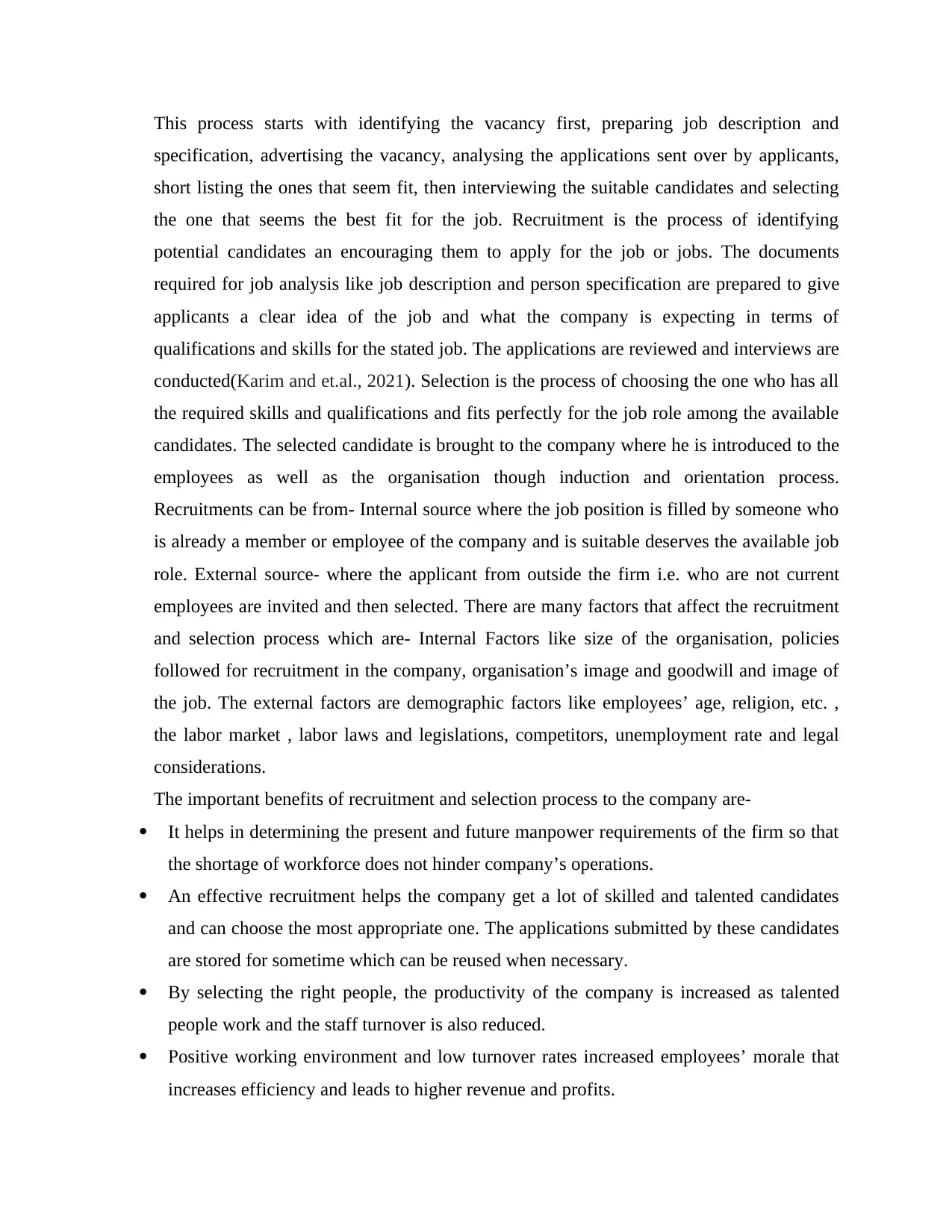
This process starts with identifying the vacancy first, preparing job description and
specification, advertising the vacancy, analysing the applications sent over by applicants,
short listing the ones that seem fit, then interviewing the suitable candidates and selecting
the one that seems the best fit for the job. Recruitment is the process of identifying
potential candidates an encouraging them to apply for the job or jobs. The documents
required for job analysis like job description and person specification are prepared to give
applicants a clear idea of the job and what the company is expecting in terms of
qualifications and skills for the stated job. The applications are reviewed and interviews are
conducted(Karim and et.al., 2021). Selection is the process of choosing the one who has all
the required skills and qualifications and fits perfectly for the job role among the available
candidates. The selected candidate is brought to the company where he is introduced to the
employees as well as the organisation though induction and orientation process.
Recruitments can be from- Internal source where the job position is filled by someone who
is already a member or employee of the company and is suitable deserves the available job
role. External source- where the applicant from outside the firm i.e. who are not current
employees are invited and then selected. There are many factors that affect the recruitment
and selection process which are- Internal Factors like size of the organisation, policies
followed for recruitment in the company, organisation’s image and goodwill and image of
the job. The external factors are demographic factors like employees’ age, religion, etc. ,
the labor market , labor laws and legislations, competitors, unemployment rate and legal
considerations.
The important benefits of recruitment and selection process to the company are-
It helps in determining the present and future manpower requirements of the firm so that
the shortage of workforce does not hinder company’s operations.
An effective recruitment helps the company get a lot of skilled and talented candidates
and can choose the most appropriate one. The applications submitted by these candidates
are stored for sometime which can be reused when necessary.
By selecting the right people, the productivity of the company is increased as talented
people work and the staff turnover is also reduced.
Positive working environment and low turnover rates increased employees’ morale that
increases efficiency and leads to higher revenue and profits.
specification, advertising the vacancy, analysing the applications sent over by applicants,
short listing the ones that seem fit, then interviewing the suitable candidates and selecting
the one that seems the best fit for the job. Recruitment is the process of identifying
potential candidates an encouraging them to apply for the job or jobs. The documents
required for job analysis like job description and person specification are prepared to give
applicants a clear idea of the job and what the company is expecting in terms of
qualifications and skills for the stated job. The applications are reviewed and interviews are
conducted(Karim and et.al., 2021). Selection is the process of choosing the one who has all
the required skills and qualifications and fits perfectly for the job role among the available
candidates. The selected candidate is brought to the company where he is introduced to the
employees as well as the organisation though induction and orientation process.
Recruitments can be from- Internal source where the job position is filled by someone who
is already a member or employee of the company and is suitable deserves the available job
role. External source- where the applicant from outside the firm i.e. who are not current
employees are invited and then selected. There are many factors that affect the recruitment
and selection process which are- Internal Factors like size of the organisation, policies
followed for recruitment in the company, organisation’s image and goodwill and image of
the job. The external factors are demographic factors like employees’ age, religion, etc. ,
the labor market , labor laws and legislations, competitors, unemployment rate and legal
considerations.
The important benefits of recruitment and selection process to the company are-
It helps in determining the present and future manpower requirements of the firm so that
the shortage of workforce does not hinder company’s operations.
An effective recruitment helps the company get a lot of skilled and talented candidates
and can choose the most appropriate one. The applications submitted by these candidates
are stored for sometime which can be reused when necessary.
By selecting the right people, the productivity of the company is increased as talented
people work and the staff turnover is also reduced.
Positive working environment and low turnover rates increased employees’ morale that
increases efficiency and leads to higher revenue and profits.
Paraphrase This Document
Need a fresh take? Get an instant paraphrase of this document with our AI Paraphraser
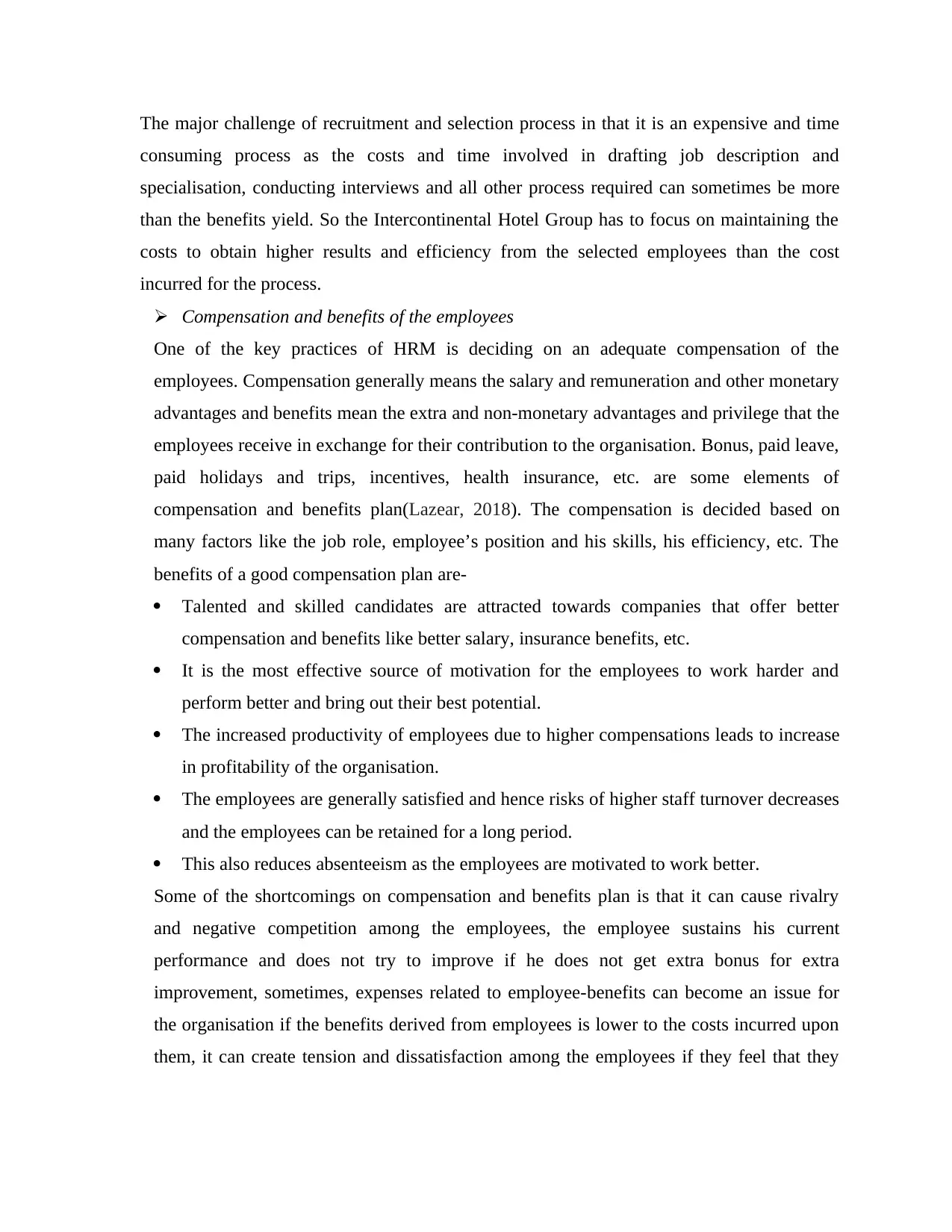
The major challenge of recruitment and selection process in that it is an expensive and time
consuming process as the costs and time involved in drafting job description and
specialisation, conducting interviews and all other process required can sometimes be more
than the benefits yield. So the Intercontinental Hotel Group has to focus on maintaining the
costs to obtain higher results and efficiency from the selected employees than the cost
incurred for the process.
Compensation and benefits of the employees
One of the key practices of HRM is deciding on an adequate compensation of the
employees. Compensation generally means the salary and remuneration and other monetary
advantages and benefits mean the extra and non-monetary advantages and privilege that the
employees receive in exchange for their contribution to the organisation. Bonus, paid leave,
paid holidays and trips, incentives, health insurance, etc. are some elements of
compensation and benefits plan(Lazear, 2018). The compensation is decided based on
many factors like the job role, employee’s position and his skills, his efficiency, etc. The
benefits of a good compensation plan are-
Talented and skilled candidates are attracted towards companies that offer better
compensation and benefits like better salary, insurance benefits, etc.
It is the most effective source of motivation for the employees to work harder and
perform better and bring out their best potential.
The increased productivity of employees due to higher compensations leads to increase
in profitability of the organisation.
The employees are generally satisfied and hence risks of higher staff turnover decreases
and the employees can be retained for a long period.
This also reduces absenteeism as the employees are motivated to work better.
Some of the shortcomings on compensation and benefits plan is that it can cause rivalry
and negative competition among the employees, the employee sustains his current
performance and does not try to improve if he does not get extra bonus for extra
improvement, sometimes, expenses related to employee-benefits can become an issue for
the organisation if the benefits derived from employees is lower to the costs incurred upon
them, it can create tension and dissatisfaction among the employees if they feel that they
consuming process as the costs and time involved in drafting job description and
specialisation, conducting interviews and all other process required can sometimes be more
than the benefits yield. So the Intercontinental Hotel Group has to focus on maintaining the
costs to obtain higher results and efficiency from the selected employees than the cost
incurred for the process.
Compensation and benefits of the employees
One of the key practices of HRM is deciding on an adequate compensation of the
employees. Compensation generally means the salary and remuneration and other monetary
advantages and benefits mean the extra and non-monetary advantages and privilege that the
employees receive in exchange for their contribution to the organisation. Bonus, paid leave,
paid holidays and trips, incentives, health insurance, etc. are some elements of
compensation and benefits plan(Lazear, 2018). The compensation is decided based on
many factors like the job role, employee’s position and his skills, his efficiency, etc. The
benefits of a good compensation plan are-
Talented and skilled candidates are attracted towards companies that offer better
compensation and benefits like better salary, insurance benefits, etc.
It is the most effective source of motivation for the employees to work harder and
perform better and bring out their best potential.
The increased productivity of employees due to higher compensations leads to increase
in profitability of the organisation.
The employees are generally satisfied and hence risks of higher staff turnover decreases
and the employees can be retained for a long period.
This also reduces absenteeism as the employees are motivated to work better.
Some of the shortcomings on compensation and benefits plan is that it can cause rivalry
and negative competition among the employees, the employee sustains his current
performance and does not try to improve if he does not get extra bonus for extra
improvement, sometimes, expenses related to employee-benefits can become an issue for
the organisation if the benefits derived from employees is lower to the costs incurred upon
them, it can create tension and dissatisfaction among the employees if they feel that they
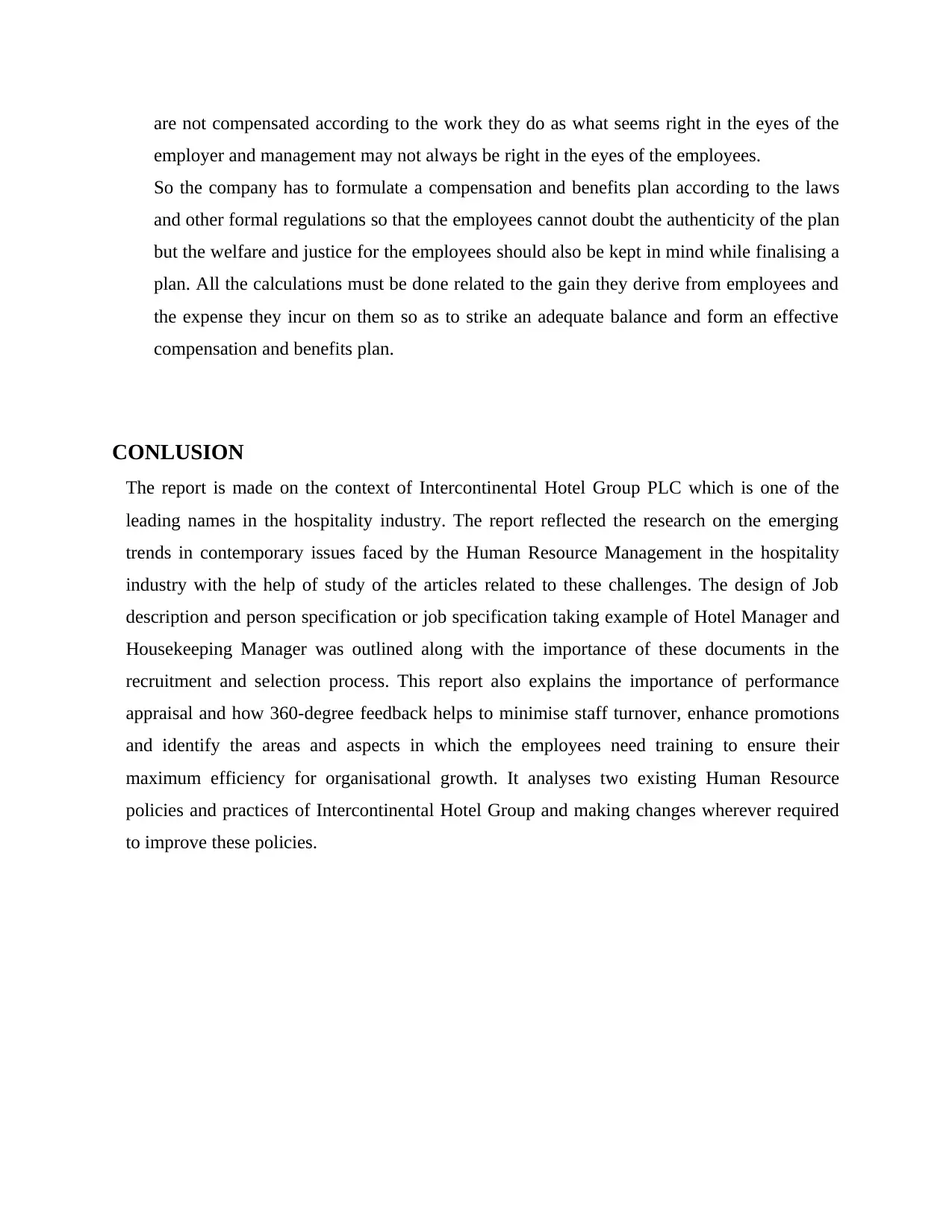
are not compensated according to the work they do as what seems right in the eyes of the
employer and management may not always be right in the eyes of the employees.
So the company has to formulate a compensation and benefits plan according to the laws
and other formal regulations so that the employees cannot doubt the authenticity of the plan
but the welfare and justice for the employees should also be kept in mind while finalising a
plan. All the calculations must be done related to the gain they derive from employees and
the expense they incur on them so as to strike an adequate balance and form an effective
compensation and benefits plan.
CONLUSION
The report is made on the context of Intercontinental Hotel Group PLC which is one of the
leading names in the hospitality industry. The report reflected the research on the emerging
trends in contemporary issues faced by the Human Resource Management in the hospitality
industry with the help of study of the articles related to these challenges. The design of Job
description and person specification or job specification taking example of Hotel Manager and
Housekeeping Manager was outlined along with the importance of these documents in the
recruitment and selection process. This report also explains the importance of performance
appraisal and how 360-degree feedback helps to minimise staff turnover, enhance promotions
and identify the areas and aspects in which the employees need training to ensure their
maximum efficiency for organisational growth. It analyses two existing Human Resource
policies and practices of Intercontinental Hotel Group and making changes wherever required
to improve these policies.
employer and management may not always be right in the eyes of the employees.
So the company has to formulate a compensation and benefits plan according to the laws
and other formal regulations so that the employees cannot doubt the authenticity of the plan
but the welfare and justice for the employees should also be kept in mind while finalising a
plan. All the calculations must be done related to the gain they derive from employees and
the expense they incur on them so as to strike an adequate balance and form an effective
compensation and benefits plan.
CONLUSION
The report is made on the context of Intercontinental Hotel Group PLC which is one of the
leading names in the hospitality industry. The report reflected the research on the emerging
trends in contemporary issues faced by the Human Resource Management in the hospitality
industry with the help of study of the articles related to these challenges. The design of Job
description and person specification or job specification taking example of Hotel Manager and
Housekeeping Manager was outlined along with the importance of these documents in the
recruitment and selection process. This report also explains the importance of performance
appraisal and how 360-degree feedback helps to minimise staff turnover, enhance promotions
and identify the areas and aspects in which the employees need training to ensure their
maximum efficiency for organisational growth. It analyses two existing Human Resource
policies and practices of Intercontinental Hotel Group and making changes wherever required
to improve these policies.
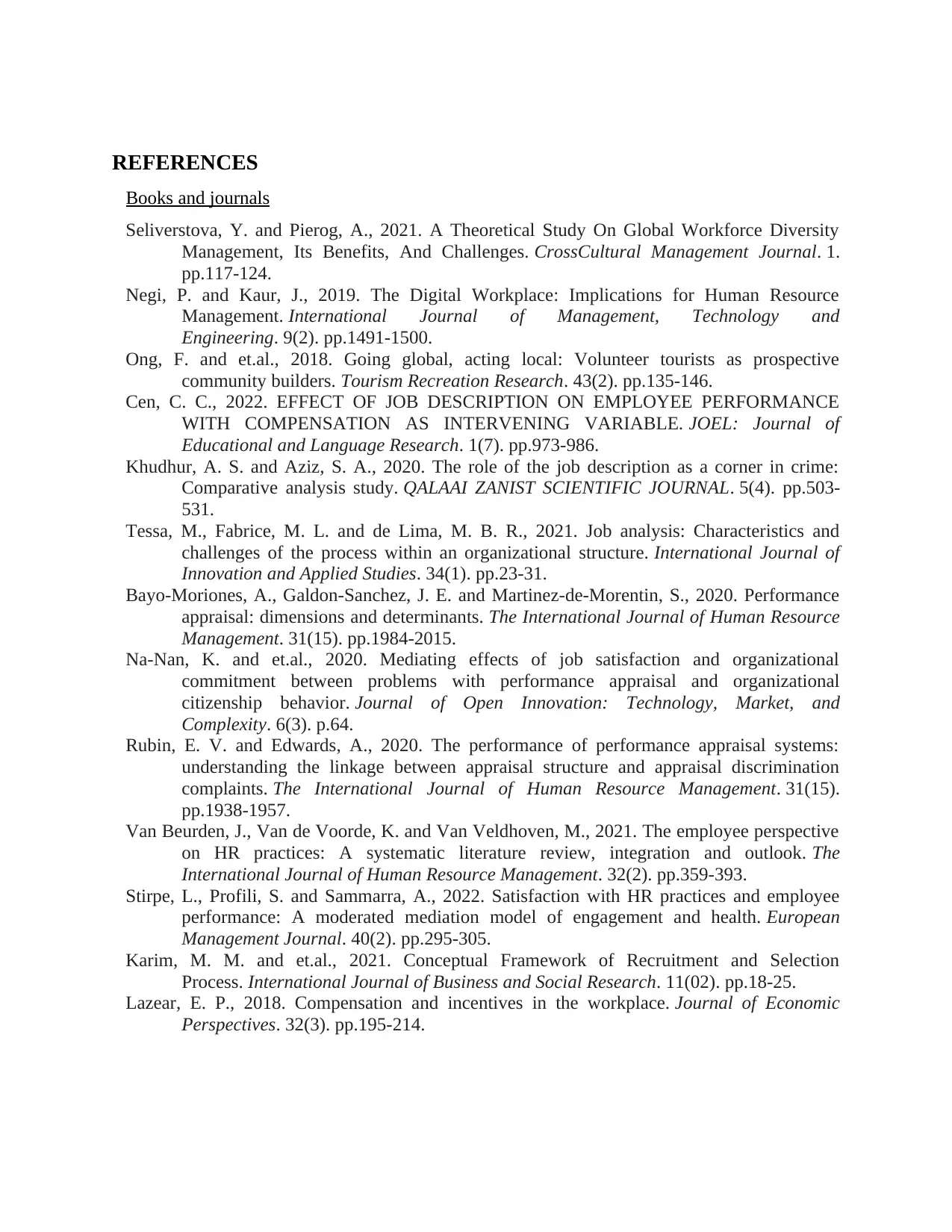
REFERENCES
Books and journals
Seliverstova, Y. and Pierog, A., 2021. A Theoretical Study On Global Workforce Diversity
Management, Its Benefits, And Challenges. CrossCultural Management Journal. 1.
pp.117-124.
Negi, P. and Kaur, J., 2019. The Digital Workplace: Implications for Human Resource
Management. International Journal of Management, Technology and
Engineering. 9(2). pp.1491-1500.
Ong, F. and et.al., 2018. Going global, acting local: Volunteer tourists as prospective
community builders. Tourism Recreation Research. 43(2). pp.135-146.
Cen, C. C., 2022. EFFECT OF JOB DESCRIPTION ON EMPLOYEE PERFORMANCE
WITH COMPENSATION AS INTERVENING VARIABLE. JOEL: Journal of
Educational and Language Research. 1(7). pp.973-986.
Khudhur, A. S. and Aziz, S. A., 2020. The role of the job description as a corner in crime:
Comparative analysis study. QALAAI ZANIST SCIENTIFIC JOURNAL. 5(4). pp.503-
531.
Tessa, M., Fabrice, M. L. and de Lima, M. B. R., 2021. Job analysis: Characteristics and
challenges of the process within an organizational structure. International Journal of
Innovation and Applied Studies. 34(1). pp.23-31.
Bayo-Moriones, A., Galdon-Sanchez, J. E. and Martinez-de-Morentin, S., 2020. Performance
appraisal: dimensions and determinants. The International Journal of Human Resource
Management. 31(15). pp.1984-2015.
Na-Nan, K. and et.al., 2020. Mediating effects of job satisfaction and organizational
commitment between problems with performance appraisal and organizational
citizenship behavior. Journal of Open Innovation: Technology, Market, and
Complexity. 6(3). p.64.
Rubin, E. V. and Edwards, A., 2020. The performance of performance appraisal systems:
understanding the linkage between appraisal structure and appraisal discrimination
complaints. The International Journal of Human Resource Management. 31(15).
pp.1938-1957.
Van Beurden, J., Van de Voorde, K. and Van Veldhoven, M., 2021. The employee perspective
on HR practices: A systematic literature review, integration and outlook. The
International Journal of Human Resource Management. 32(2). pp.359-393.
Stirpe, L., Profili, S. and Sammarra, A., 2022. Satisfaction with HR practices and employee
performance: A moderated mediation model of engagement and health. European
Management Journal. 40(2). pp.295-305.
Karim, M. M. and et.al., 2021. Conceptual Framework of Recruitment and Selection
Process. International Journal of Business and Social Research. 11(02). pp.18-25.
Lazear, E. P., 2018. Compensation and incentives in the workplace. Journal of Economic
Perspectives. 32(3). pp.195-214.
Books and journals
Seliverstova, Y. and Pierog, A., 2021. A Theoretical Study On Global Workforce Diversity
Management, Its Benefits, And Challenges. CrossCultural Management Journal. 1.
pp.117-124.
Negi, P. and Kaur, J., 2019. The Digital Workplace: Implications for Human Resource
Management. International Journal of Management, Technology and
Engineering. 9(2). pp.1491-1500.
Ong, F. and et.al., 2018. Going global, acting local: Volunteer tourists as prospective
community builders. Tourism Recreation Research. 43(2). pp.135-146.
Cen, C. C., 2022. EFFECT OF JOB DESCRIPTION ON EMPLOYEE PERFORMANCE
WITH COMPENSATION AS INTERVENING VARIABLE. JOEL: Journal of
Educational and Language Research. 1(7). pp.973-986.
Khudhur, A. S. and Aziz, S. A., 2020. The role of the job description as a corner in crime:
Comparative analysis study. QALAAI ZANIST SCIENTIFIC JOURNAL. 5(4). pp.503-
531.
Tessa, M., Fabrice, M. L. and de Lima, M. B. R., 2021. Job analysis: Characteristics and
challenges of the process within an organizational structure. International Journal of
Innovation and Applied Studies. 34(1). pp.23-31.
Bayo-Moriones, A., Galdon-Sanchez, J. E. and Martinez-de-Morentin, S., 2020. Performance
appraisal: dimensions and determinants. The International Journal of Human Resource
Management. 31(15). pp.1984-2015.
Na-Nan, K. and et.al., 2020. Mediating effects of job satisfaction and organizational
commitment between problems with performance appraisal and organizational
citizenship behavior. Journal of Open Innovation: Technology, Market, and
Complexity. 6(3). p.64.
Rubin, E. V. and Edwards, A., 2020. The performance of performance appraisal systems:
understanding the linkage between appraisal structure and appraisal discrimination
complaints. The International Journal of Human Resource Management. 31(15).
pp.1938-1957.
Van Beurden, J., Van de Voorde, K. and Van Veldhoven, M., 2021. The employee perspective
on HR practices: A systematic literature review, integration and outlook. The
International Journal of Human Resource Management. 32(2). pp.359-393.
Stirpe, L., Profili, S. and Sammarra, A., 2022. Satisfaction with HR practices and employee
performance: A moderated mediation model of engagement and health. European
Management Journal. 40(2). pp.295-305.
Karim, M. M. and et.al., 2021. Conceptual Framework of Recruitment and Selection
Process. International Journal of Business and Social Research. 11(02). pp.18-25.
Lazear, E. P., 2018. Compensation and incentives in the workplace. Journal of Economic
Perspectives. 32(3). pp.195-214.
1 out of 16
Related Documents
Your All-in-One AI-Powered Toolkit for Academic Success.
+13062052269
info@desklib.com
Available 24*7 on WhatsApp / Email
![[object Object]](/_next/static/media/star-bottom.7253800d.svg)
Unlock your academic potential
© 2024 | Zucol Services PVT LTD | All rights reserved.


